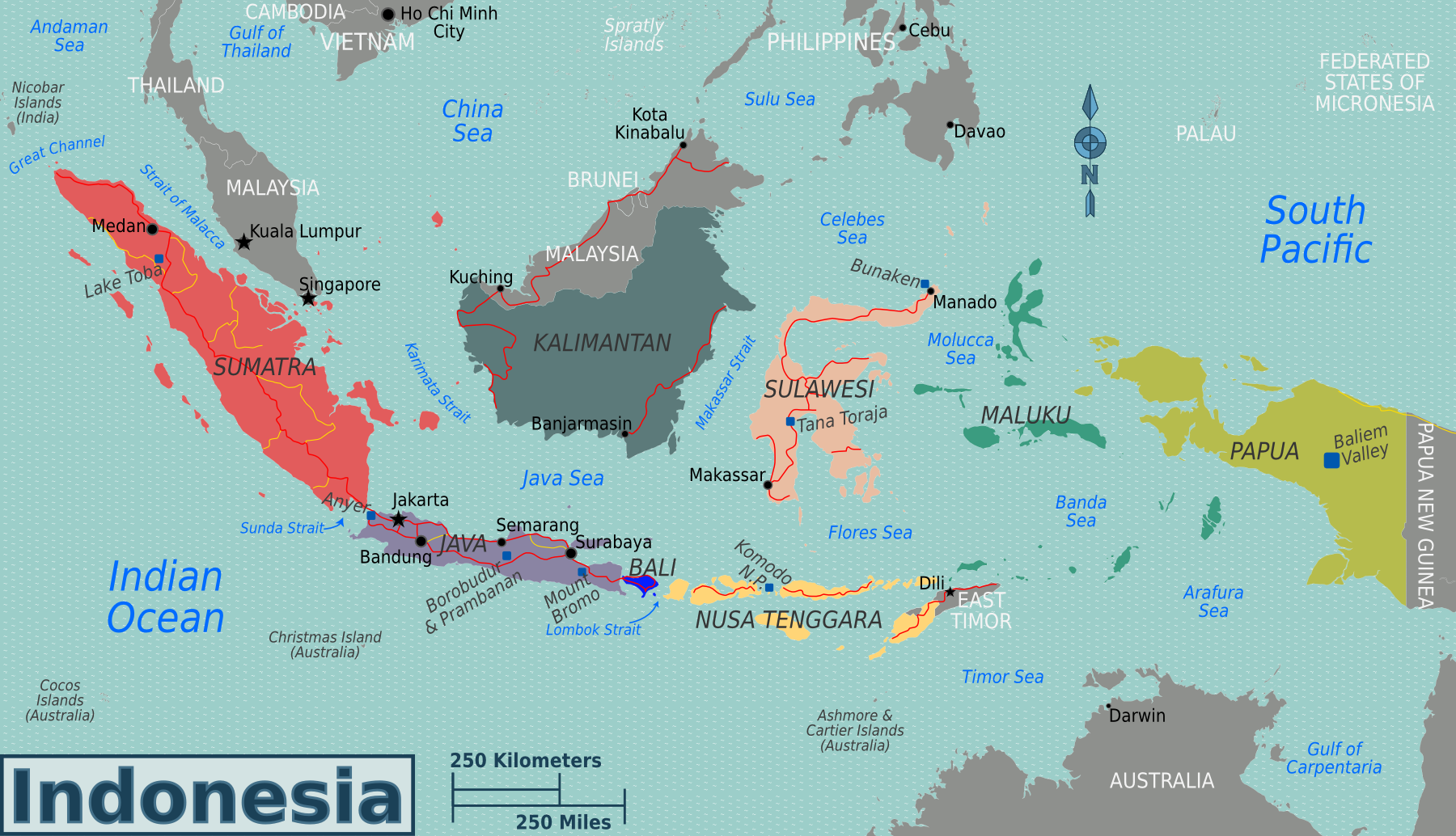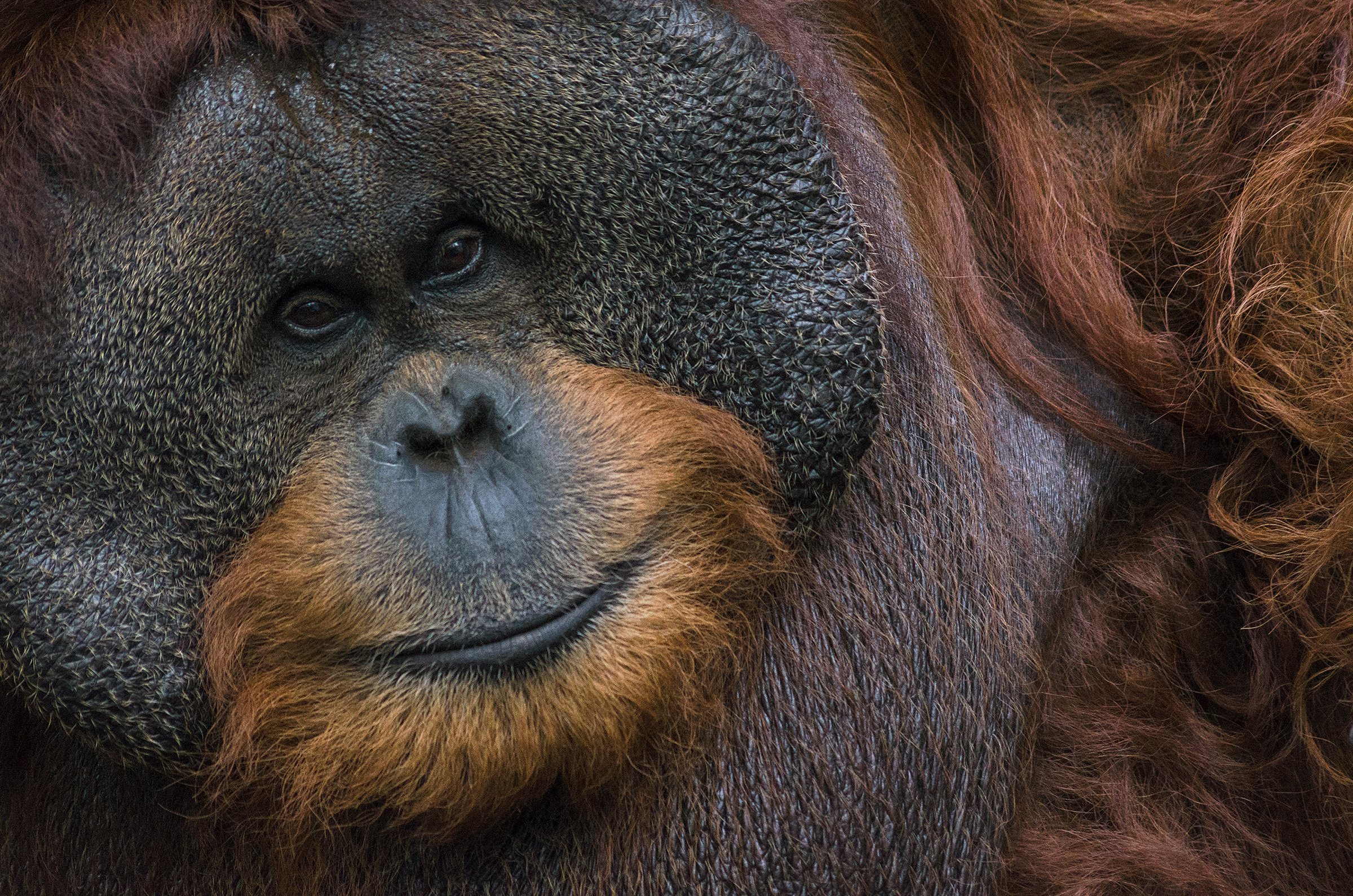|
Lamandau River
Lamandau River ( id, Sungai Lamandau) is a river of Kalimantan, southern-central Borneo, Indonesia. Downstream after passing the village of Nanga Bulik it becomes the Kotawaringin River. The ancient town of Kotawaringin is located in the valley formed by the river and its tributary along with gold and gemstone mining areas. In the upper reaches of the tributary valley of Arut River the Pangkalan Bun town flourishes on its banks. Hydrology Lamandau River flows through southern Central Kalimantan and Pangkalan Bun, discharging into the Java Sea near Kumai at . It is a major tributary of Kotawaringin River, known by this name after its confluence below Naga Bulik village. Tributaries include the Arut River, where in its upper reaches the Pangkalan Bun town is located. While the lower reaches of the river are densely populated, the upper reaches have contiguous forest areas where Orangutans can be seen. Kotawaringin town to the west of the Lamandau River was an ancient capital of a S ... [...More Info...] [...Related Items...] OR: [Wikipedia] [Google] [Baidu] |
Kalimantan
Kalimantan () is the Indonesian portion of the island of Borneo. It constitutes 73% of the island's area. The non-Indonesian parts of Borneo are Brunei and East Malaysia. In Indonesia, "Kalimantan" refers to the whole island of Borneo. In 2019, President of Indonesia Joko Widodo proposed that Capital of Indonesia, Indonesia's capital be moved to Kalimantan, and in January 2022 Indonesian legislature approved the proposal. The shift is expected to take up to 10 years. Etymology The name ''Kalimantan'' is derived from the Sanskrit word ''Kalamanthana'', which means "burning weather island", or island with a very hot temperature, referring to its hot and humid tropical climate. It consists of the two words ''Kāla (time), kal[a]'' ("time, season, period") and ''manthan[a]'' ("boiling, churning, burning"). The indigenous people of the eastern region of Borneo referred to their island as ''Pulu K'lemantan'' or "Kalimantan" when the sixteenth century Portuguese explorer Jorge de Meneze ... [...More Info...] [...Related Items...] OR: [Wikipedia] [Google] [Baidu] |
Dayak People
The Dayak (; older spelling: Dajak) or Dyak or Dayuh are one of the native groups of Borneo. It is a loose term for over 200 riverine and hill-dwelling ethnic groups, located principally in the central and southern interior of Borneo, each with its own dialect, customs, laws, territory, and culture, although common distinguishing traits are readily identifiable. Dayak languages are categorised as part of the Austronesian languages. The Dayak were animist (Kaharingan and Folk Hindus) in belief; however, since the 19th century there has been mass conversion to Christianity as well as Islam due to the spreading of Abrahamic religions. Etymology It is commonly assumed that the name originates from the Bruneian and Melanau word for “interior people”, without any reference to an exact ethnic group. The term was adopted by Dutch and German authors as an umbrella term for any non-Muslim natives of Borneo. Thus, the difference between Dayaks and non-Dayaks natives could be un ... [...More Info...] [...Related Items...] OR: [Wikipedia] [Google] [Baidu] |
List Of Rivers Of Kalimantan
{{DEFAULTSORT:Rivers of Kalimantan ...
List of rivers flowing in Kalimantan,''Map of Indonesia''. Peta Indonesia. Wawasan Nusantara. CV. Indo Prima Sarana. Accessed 29 Juli 2017. which is Indonesian portion of the island of Borneo, comprising 73% of the island's area. In alphabetical order By Province Central Kalimantan East Kalimantan North Kalimantan South Kalimantan West Kalimantan See also * List of rivers of Indonesia References Kalimantan Kalimantan Kalimantan () is the Indonesian portion of the island of Borneo. It constitutes 73% of the island's area. The non-Indonesian parts of Borneo are Brunei and East Malaysia. In Indonesia, "Kalimantan" refers to the whole island of Borneo. In 2019, ... [...More Info...] [...Related Items...] OR: [Wikipedia] [Google] [Baidu] |
List Of Rivers Of Indonesia
This is a list of rivers in Indonesia.''Map of Indonesia''. Peta Indonesia. Wawasan Nusantara. CV. Indo Prima Sarana. Accessed 29 Juli 2017. By island This list is arranged by island in alphabetical order, with respective tributaries indented under each larger stream's name. Ambon * Sikula Bali Buru * Waeapo Flores Java Kalimantan : ''Below are the rivers in the Indonesian territory of Borneo (Kalimantan)'' Papua Seram Sulawesi * ''Tamborasi River'' Sumatra Sumba Sumbawa West Timor West Timor ( id, Timor Barat) is an area covering the western part of the island of Timor, except for the district of Oecussi-Ambeno (an East Timorese exclave). Administratively, West Timor is part of East Nusa Tenggara Province, Indonesia. The ca ... By province Notes and references Sources *Rand McNally, ''The New International Atlas'', 1993. GEOnet Names Server [...More Info...] [...Related Items...] OR: [Wikipedia] [Google] [Baidu] |
Illegal Logging
Illegal logging is the harvest, transportation, purchase or sale of timber in violation of laws. The harvesting procedure itself may be illegal, including using corrupt means to gain access to forests; extraction without permission, or from a protected area; the cutting down of protected species; or the extraction of timber in excess of agreed limits. Illegal logging is a driving force for a number of environmental issues such as deforestation, soil erosion and biodiversity loss which can drive larger scale environmental crisis such as climate change and other forms of environmental degradation. Illegality may also occur during transport, such as illegal processing and export (through fraudulent declaration to customs); the avoidance of taxes and other charges, and fraudulent certification. These acts are often referred to as "wood laundering". Illegal logging is driven by a number of economic forces, such as demand for raw materials, land grabbing and demand for pasture for ... [...More Info...] [...Related Items...] OR: [Wikipedia] [Google] [Baidu] |
Zircon
Zircon () is a mineral belonging to the group of nesosilicates and is a source of the metal zirconium. Its chemical name is zirconium(IV) silicate, and its corresponding chemical formula is Zr SiO4. An empirical formula showing some of the range of substitution in zircon is (Zr1–y, REEy)(SiO4)1–x(OH)4x–y. Zircon precipitates from silicate melts and has relatively high concentrations of high field strength incompatible elements. For example, hafnium is almost always present in quantities ranging from 1 to 4%. The crystal structure of zircon is tetragonal crystal system. The natural color of zircon varies between colorless, yellow-golden, red, brown, blue, and green. The name derives from the Persian ''zargun'', meaning "gold-hued". This word is corrupted into "jargoon", a term applied to light-colored zircons. The English word "zircon" is derived from ''Zirkon'', which is the German adaptation of this word. Yellow, orange, and red zircon is also known as "hyacinth", ... [...More Info...] [...Related Items...] OR: [Wikipedia] [Google] [Baidu] |
Bornean Orangutan
The Bornean orangutan (''Pongo pygmaeus'') is a species of orangutan endemic to the island of Borneo. Together with the Sumatran orangutan (''Pongo abelii'') and Tapanuli orangutan (''Pongo tapanuliensis''), it belongs to the only genus of great apes native to Asia. Like the other great apes, orangutans are highly intelligent, displaying tool use and distinct cultural patterns in the wild. Orangutans share approximately 97% of their DNA with humans. Also called mias by the local population, the Bornean orangutan is a critically endangered species, with deforestation, palm oil plantations, and hunting posing a serious threat to its continued existence. Taxonomy The Bornean orangutan and the Sumatran orangutan diverged about 400,000 years ago, with a continued low level of gene flow between them since then. The two orangutan species were considered merely subspecies until 1996; they were elevated to species following sequencing of their mitochondrial DNA. The Bornean orangutan ... [...More Info...] [...Related Items...] OR: [Wikipedia] [Google] [Baidu] |
Lamandau River Wildlife Reserve
The Lamandau Nature Reserve is found in Borneo, Indonesia. This site has an area of . It is home to a number of Bornean orangutans (''Pongo pygmaeus''). It is this reserve that rehabilitates and orphan orangutans are released into by the Orangutan Foundation. (McConkey, 2005) The number of endangered orangutans is currently around 500, but that number is gradually growing as the Lamandau Nature Reserve implements a program of rehabilitation and release of orangutans into the natural environment. See also *Lamandau River Lamandau River ( id, Sungai Lamandau) is a river of Kalimantan, southern-central Borneo, Indonesia. Downstream after passing the village of Nanga Bulik it becomes the Kotawaringin River. The ancient town of Kotawaringin is located in the valley ... Further reading McConkey, M. 2005. Bornean Orangutan, In Caldecotte, J. and Miles., eds, World Atlas of Great Apes and their conservation. Prepared at the UNEP World Conservation Monitoring Centre. University of Ca ... [...More Info...] [...Related Items...] OR: [Wikipedia] [Google] [Baidu] |
Jelai-Bila River
The Jelai-Bila River is a river of Central Kalimantan, Indonesia, about 600 km northeast of the capital Jakarta. at Geonames.org (cc-by); Last updated 2013-06-04; Database dump downloaded 2015-11-27 Much of the land between the and the Jelai-Bila River is developed by agriculture. Geography The river flows in the central south of Borneo with predominantly (designated as ''Am'' in the Köppen-Geiger climate classification). The annual aver ...[...More Info...] [...Related Items...] OR: [Wikipedia] [Google] [Baidu] |
Klotok
A klotok is a traditional river boat used to navigate the waters of Indonesia. Fitted with inboard or outboard motors, klotoks are primarily used for cabotage up rivers, transporting people and goods. Klotoks are found in floating marketplaces, national parks, and fishing areas. Depending on their function or how they are equipped, they may be called by various names. Etymology The boat's name refers to the noise it makes, “klok tok tok tok”. The klotok may also be referred to by other names, such as water taxi, or “motorized gondola” or “mini-trawler”. Design The klotok is a wooden river boat with a shallow draft. Its size varies somewhat by use. Common sizes are by , such as for a dugout, or by for a small commercial boat. It can be even larger, such as a houseboat. Klotok often have a roof, which forms an upper deck for tourists. The boats may be fitted with inboard engines. Klotoks have varying levels of accommodation, some tourist vessels may provide passenger ... [...More Info...] [...Related Items...] OR: [Wikipedia] [Google] [Baidu] |
Tumon
Tumon ( ch, Tomhom) is a district located on Tumon Bay along the northwest coast of the United States unincorporated territory of Guam. Located in the municipality of Tamuning, it is the center of Guam's tourist industry. History Tumon Bay or Agana Bay are the most likely locations that Ferdinand Magellan dropped anchor on March 6, 1521, though there was little further contact for the next 150 years. When the Spanish Empire colonized Guam in 1668, ''Tomhom'' was one of the most prominent villages. The first Roman Catholic missionaries to the island, the Jesuit Padre (''Pålé''), the Spanish priest Blessed Diego Luis de San Vitores and his sacristan, the Visayan Saint Pedro Calungsod were killed in Tumon by the village chief Matå'pang after San Vitores had baptised the chief's daughter without permission, but with mother's permission. This was an early inciting incident of the Spanish-Chamorro Wars. A park and statue mark the site of De San Vitores and Calungsod's martyrdom ... [...More Info...] [...Related Items...] OR: [Wikipedia] [Google] [Baidu] |






